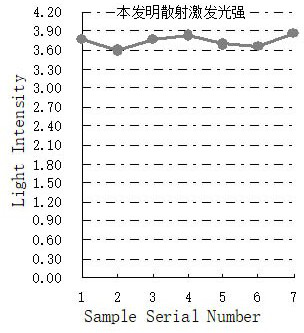Multi-scattering system self-adaptive fluorescence detection system and detection method
A fluorescence detection and self-adaptive technology, applied in fluorescence/phosphorescence, measurement devices, material analysis through optical means, etc., can solve the problems of reducing the accuracy of detection results, the error of fluorescence signal intensity, and the inability to deal with it, so as to eliminate the fluorescence signal Intensity difference, effect of eliminating quantitative detection error
- Summary
- Abstract
- Description
- Claims
- Application Information
AI Technical Summary
Problems solved by technology
Method used
Image
Examples
Embodiment 1
[0032] Such as figure 1 As shown, a multi-scattering system adaptive fluorescence detection system in this embodiment includes: a fluorescence collecting lens 101, a primary dichroic mirror 102, an excitation light path 103, a secondary dichroic mirror 104, a first converging lens 105, A first photoelectric conversion detector 106, a bandpass filter 107, a second converging lens 108, and a second photoelectric conversion detector 109;
[0033] The excitation light in a parallel state emitted by the excitation light optical path 103 is incident on the main dichroic mirror 102 and then reflected on the fluorescence collection lens 101, and then irradiated into the sample after being converged by the fluorescence collection lens 101;
[0034] The fluorescence generated by the excitation of the sample is collimated by the fluorescence collecting lens 101, then transmits the primary dichroic mirror 102 and the secondary dichroic mirror 104 sequentially, and then is filtered by the ...
Embodiment 2
[0050] This embodiment provides a multi-scattering system adaptive fluorescence detection method, which uses the multi-scattering system adaptive fluorescence detection system in Embodiment 1 to perform fluorescence detection on the sample, and then uses the target fluorescence energy obtained by the second photoelectric conversion detector 109 The concentration of the sample to be tested is calculated by the ratio of the intensity to the energy intensity of the excitation light obtained by the first photoelectric conversion detector 106.
[0051] Since the macromolecular clusters in the sample have the same scattering effect on the incident excitation light and the emitted fluorescence, when the sample scattering system changes, the scattered excitation light and The proportion of fluorescence changes quite; since the proportions of reflection, transmission and absorption of each optical device in the same optical system to different wavelengths are fixed, when the sample scat...
Embodiment 3
[0061] Comparison between the detection system of the present invention and the conventional fluorescence detection system, wherein, compared with the present invention, the conventional fluorescence detection system lacks the secondary dichroic mirror 104 and the first photoelectric conversion detector 106, and the second photoelectric conversion detector 109 only detects the fluorescent signal entering the detection light path.
[0062] The detection system of Example 2 of the present invention and the conventional fluorescence detection system are used to detect the same sample. The specific measurement method and process are as follows: first, a test sample is divided into 7 equal parts, respectively numbered 1-7, that is, numbered For the 7 sub-samples of 1-7, since the 7 sub-samples all come from the same test sample, their material composition is the same; then the 7 sub-samples are subjected to sample pretreatment according to the same method steps, after the treatment ...
PUM
 Login to View More
Login to View More Abstract
Description
Claims
Application Information
 Login to View More
Login to View More - R&D
- Intellectual Property
- Life Sciences
- Materials
- Tech Scout
- Unparalleled Data Quality
- Higher Quality Content
- 60% Fewer Hallucinations
Browse by: Latest US Patents, China's latest patents, Technical Efficacy Thesaurus, Application Domain, Technology Topic, Popular Technical Reports.
© 2025 PatSnap. All rights reserved.Legal|Privacy policy|Modern Slavery Act Transparency Statement|Sitemap|About US| Contact US: help@patsnap.com



